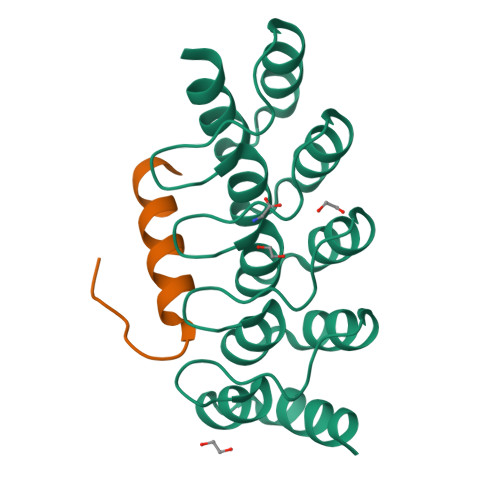Trapping the HIV-1 V3 loop in a helical conformation enables broad neutralization.
Glogl, M., Friedrich, N., Cerutti, G., Lemmin, T., Kwon, Y.D., Gorman, J., Maliqi, L., Mittl, P.R.E., Hesselman, M.C., Schmidt, D., Weber, J., Foulkes, C., Dingens, A.S., Bylund, T., Olia, A.S., Verardi, R., Reinberg, T., Baumann, N.S., Rusert, P., Dreier, B., Shapiro, L., Kwong, P.D., Pluckthun, A., Trkola, A.(2023) Nat Struct Mol Biol 30: 1323-1336
- PubMed: 37605043
- DOI: https://doi.org/10.1038/s41594-023-01062-z
- Primary Citation of Related Structures:
7TXD, 7Z7C, 8AED - PubMed Abstract:
The third variable (V3) loop on the human immunodeficiency virus 1 (HIV-1) envelope glycoprotein trimer is indispensable for virus cell entry. Conformational masking of V3 within the trimer allows efficient neutralization via V3 only by rare, broadly neutralizing glycan-dependent antibodies targeting the closed prefusion trimer but not by abundant antibodies that access the V3 crown on open trimers after CD4 attachment. Here, we report on a distinct category of V3-specific inhibitors based on designed ankyrin repeat protein (DARPin) technology that reinstitute the CD4-bound state as a key neutralization target with up to >90% breadth. Broadly neutralizing DARPins (bnDs) bound V3 solely on open envelope and recognized a four-turn amphipathic α-helix in the carboxy-terminal half of V3 (amino acids 314-324), which we termed 'αV3C'. The bnD contact surface on αV3C was as conserved as the CD4 binding site. Molecular dynamics and escape mutation analyses underscored the functional relevance of αV3C, highlighting the potential of αV3C-based inhibitors and, more generally, of postattachment inhibition of HIV-1.
Organizational Affiliation:
Institute for Medical Virology, University of Zurich (UZH), Zurich, Switzerland.



















